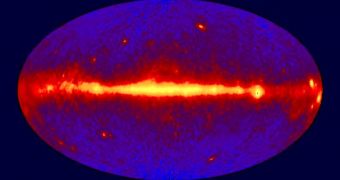A team of astrophysicists including experts from the Padova University and the National Institute of Nuclear Physics, both in Italy, announces that massive, hot cosmic superbubbles may be the source for extremely energetic radiations called gamma rays.
Such large-scale structures can for example be produced by stars in a young cluster. These objects would heat up vast volumes of gas in their stellar nurseries, which would then appear as a massive bubble in space.
Stars usually form inside clouds of cosmic dust and molecular hydrogen gas. After they first form, powerful stellar winds sweep the dust and gas from all around them, allowing the objects to endure.
But scientists say that complex physical phenomena are compounded when this process occurs in a stellar nursery. There could be tens of new stars contributing to punching a hole through the clouds surrounding them. The interplay that occurs as a result of this may produce cosmic rays.
These are the most energetic forms of radiation known to exist in space. They cannot be replicated on Earth, as we do not have the means to produce such high energy output. Despite the fact that cosmic rays have been known for decades, experts still have no clear proof on how they form.
For the new investigation, astrophysicists turned their attention to a region of the Cygnus constellation known as Cygnus X. The area displays a cosmic superbubble that is most likely produced by the Cygnus OB2 star cluster.
Details of the study were published in the November 25 issue of the top journal Science.
The area contains more than 500 stars, all of which are at least 10 times heavier than the Sun. The new study was conducted using data from the NASA Fermi Large Area Telescope (LAT). Experts say that the gamma-ray signs they detected indicated the radiations were just produced.
One of the main reasons why scientists found it so difficult to determine the origins of cosmic rays until now was the fact that these radiations are extremely prone to being influenced by electromagnetic fields around massive bodies.
“For the first time, we have caught a glimpse of the early life of cosmic rays in these regions of massive star formation,” explains experimental physicist and study coauthor Luigi Tibaldo, who is based at both research institutions.
“This might really change the way we think cosmic rays propagate, and if they're giving off energy as they're trapped inside star-forming regions, they may be changing the chemistry within, affecting how stars form,” adds Paris Diderot University astronomer Isabelle Grenier, as quoted by Space.

 14 DAY TRIAL //
14 DAY TRIAL //